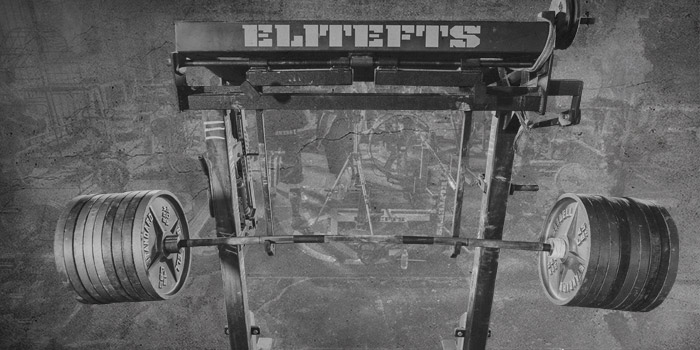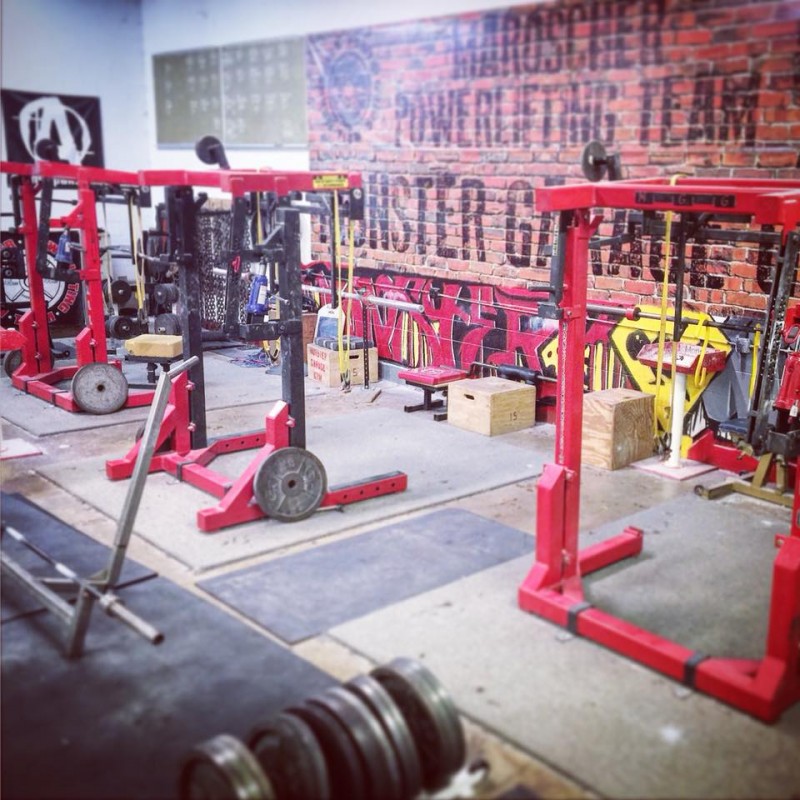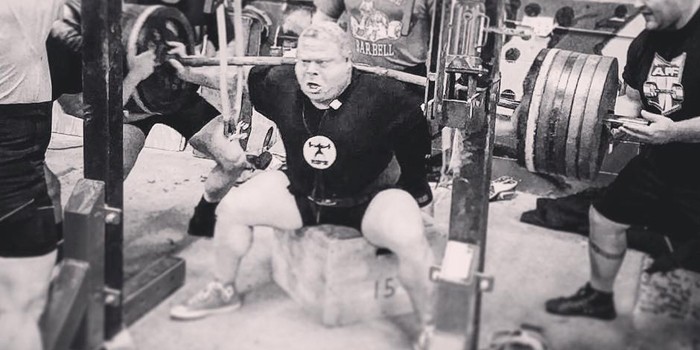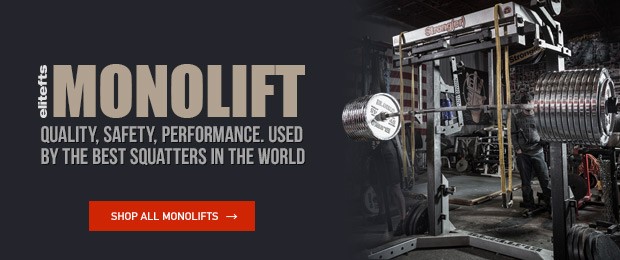
The monolift, in many ways, is the holy grail of gym equipment, and for the serious powerlifting gym, it is an absolute essential.
The modern-day monolift is built like a steel fortress and with its never compromising welds, it will last a lifetime. When it comes to putting up your absolute max poundage on the squat, it is the quintessential piece of equipment for that purpose.
That all said, if you don’t have frequent and repetitive use of a monolift, it also the piece of equipment you are sure to get hurt on if you don’t know how to use or fail to respect this metal monstrosity.
RECENT: Save It for the Barber Shop
My first experience with a monolift was back in the 1990s at the legendary Frantz Gym, and Ernie Frantz had several monolifts in the top floor of his gym (they later found their way to the basement when the lifting eventually moved to the basement of his building). Ernie’s monolifts were solid, solid enough for the 1,100-pound training squats of Frantz’s disciples like world champion Bill Nichols.
That said, these first generation monolifts would have some difficulty serving lifters today for a couple of reasons. The main reason is that the feet of the monolifts back then were much closer together than they are today. As lifting gear has graduated from thin-single-ply to canvas to the suit and brief polymers of today, this gear change has allowed for the ultra-wide stances we began to see in the early 2000s. With the first generation monolifts, the ultra-wide stanced lifter’s feet would press up against the monolift feet for sure. Also, these first models did not physically weigh what a modern monolift weighs, so too much band tension on those original models would cause that generation of monolift to flip over as the lifter stands with the bands around the barbell and the bottom of the monolift.
Those structural issues aside, what remains the same between monolifts of decades ago and the modern day versions, like the elitefts monolift, is the protocol for using the monolift, and those lessons I learned back some 20-something years ago still stand true to this day.
Using this piece of equipment and not fully understanding how it works, or not respecting it, will ultimately end in injury, and over these decades I have seen injuries happen with the monolift more times than I can recall, some of these with career-ending results.
That all said, here are my Top-5 Monolift Commandments. Monolift commandments for those new to the monolift, monolift commandments to heed today as a way to avoid tragedy in the future, and monolift commandments to help get the most out of this amazing piece of powerlifting equipment.
Let’s climb the Mount Sinai of powerlifting and examine these metaphorical tablets of stone.
1. Thou shalt not slam down the squat bar onto the monolift hooks.
This sounds more like common sense than a commandment. But I have found that when it comes to powerlifting, common sense in the weight room becomes less and less common as the use of social media becomes more and more frequent.
With those who are less experienced with this amazing piece of equipment, using the monolift will, at first, take pounds off of your squat, but eventually it will add them back and do so in a big way. I say this because lifters who are used to walking the weight out of a rack do so in a way where their final step back locks them into their final stationary position, and they are ready to squat. They have walked that weight back a thousand times, and those motor patterns have cut grooves into their squatting neural pathways to a point where those mini-steps back with the loaded bar are second nature. So naturally, when setting up in the monolift, there is no step back. You just need to stand up, squat down, and stand back up. But that is where the lifter must re-learn what position they are in without the walkout, in order to be squat-ready. They must find that sweet spot, where they are squat ready, but find it without the guidance of those familiar steps back. So the first time using that monolift, the lifter will stand up to unrack the weight, move their feet in a bit or out a bit, and ultimately, the squat just feels wrong and the weight is thus more difficult to lift. It is like that famous scene in the movie Butch Cassidy and the Sundance Kid where Robert Redford’s character is asked to hit a target from a stationary position. Although he is the best gun in the west, he can’t just aim and shoot, he has to find his shot through his familiar movement of the “quick draw.”
Squatting from a stationary position without having stepped back first can take time to perfect, even though that sounds so counterintuitive. Once the lifter gets used to setting up under a loaded bar in a monolift, that is when the magic happens. That is when they really learn how tight they can get without the walk out and that they can have a wider stance that might not be practical when taking actual steps back with a loaded bar on their back. Without the steps back, the lifter is ultra-tight, wider in stance, and ready to squat. Once those monolift arms swing out, and with that new ultra-tightness that can’t be replicated with a walkout, that is when the lifter starts to put up more weight than they ever had before. Compound that with not having spent the extra energy to walk the weight out and you are really about to start squatting some all-time weight for yourself.
As the weights get bigger and bigger, the feeling of dominating the weights grows. And with no longer a need to carefully walk back a max effort squat, just like those “I wanna be Insta-famous” deadlifters do, the squatter finishes their squat and slams that squat bar down onto the monolift hooks with that reserve of energy they still have from not having to carefully walk back a large amount of weight.
Besides the mere fact that this is a very expensive piece of equipment that needs to be respected and taken care of, when that bar is slammed down onto the hooks, it often bounces up and then away from that hook. When this happens, one end of the loaded squat bar is headed for the floor and the other is laying properly on the other monolift arm hook.
This is something I have seen at literally every powerlifting gym I have trained at except for Frantz Gym. The slamming of that bar onto that small area of the monolift hooks bounces up just high enough to clear the monolift hook, and from there, I have seen the bar crash to the ground, I have seen the bar crash down on the spotter whose side was bounced off of, I have seen the bar crash down on the lifter him/herself, and every combination thereof. Where a deadlift slammed to the ground has an entire platform of wood and rubber to absorb that kinetic energy, the monolift hook is very narrow and made of steel, and when the steel barbell hits that steel metal hook, the area where the barbell hits the hook generates that kinetic energy as the bar bends, and it shoots that barbell up, off, and away from the hook like a rubber band being released from your finger and thumb.
This is mostly something you see from newer lifters or those more seasoned lifters who are enjoying that thrill of figuring out the monolift and adding huge weights but do not have the experience to see the dangers ahead of dropping the bar onto the hooks. I have also see this with lifters who train for “show.” If they were training for “go,” they would be lifting weight that would require then to place, rather than slam the bar in the monolift because there is no extra energy for show when you are actually training.
But those bar slammers, just like those deadlift droppers are all about “please pay attention to me,” instead of letting their total do the talking for them. We all see it, we all know it is ridiculous, but those little deadlifters slam down their deadlift, and they are the same bar slammers with little squats and big egos to feed, who continue to think that the sound of the bar slamming impresses more than the weight being lifted. These are the same amateurs you might have to spot at your gym. So be careful of them as you, the spotter, might also be the one that gets hurt. Heed this commandment: Don’t slam a squat bar down on the monolift arm hooks, as that bar eventually will bounce right off of that monolift hook.
All this brings me to monolift commandment number two.
2. Thou shalt always tap and slide.
The reason there were no violators of commandment number one at Frantz Gym is because these were world class powerlifters, and they all did the “tap and slide.” When they were finished with the squat, they would lock the weight out, the monolift operator would swing the monolift arms, and lock them into place. The squatter would tap the squat bar against both arms, and with control, slide the bar down against the two steel arms and safely into the monolift arm hooks.
The tap and slide does a couple of things for you as the lifter. One, it ensures that the bar is over both monolift arm hooks. Why is this important? Because we have all twisted a bit with a max weight, and if, say, the right-hand side of the squat bar is centered over the right-hand hook of the monolift arm, but the left-hand side of the squat bar is not quite over the hook of the monolift, that lifter is set up for catastrophe when they drop the bar into what they think is two hooks. For the newbies, the slide is your guide. Why the tap is also important brings us to commandment number three.
3. Thou shalt always be cautious of the monolift operator.
The tap portion of the tap and slide is key because as a squatter, you are always a bit of a slave to the guy or gal running the monolift. You can have your max weight or sub-max weight on the bar, but if you think the monolift driver has locked the monolift arms into place and you go driving your bar hard into the arm racks only to find out they did not, in fact, have the arms locked into place with the handle, you are in trouble. The reason for tapping the bar into the arms is to quickly make sure the arms have been fully locked into place by the person running the arm of the monolift. It also gives that extra moment, that quick instance for the arms to get locked into place, as some lifters are quick to rack once locked out. This tap will be a process that the new lifter and the newbie to the racking the monolift will go through, and as time passes and after reps and reps and reps of standing, unracking, squatting, and reracking have occurred, this will become a rhythm between the monolift operator and squatter and the injury potential for mishaps will become less and less each training session.
This is just like when you have been training bench with someone for a good amount of time. You know when you need to spot their bench reps, when they are getting near their failure reps and your spotting becomes ever more ready as the reps near that point of failure. Same with this cadence of the squatter and monolift operator. Over time this will be second nature, but always be leery of a monolift operator whom you are not familiar with. Also, make sure they know how many reps you are doing, so they know when to be ready to rack it, but they should be always on the listen for the dreaded “Take it!”
4. Thou shalt use Spud Straps.
The monolift operator is crucial for your safety as are the side spotters and the spotter behind you. That said, sometimes things still go wrong. I have been around the block long enough to have seen training injuries that frankly I wish I could unsee, but you can’t, and you learn from them. When a squatter’s knee goes or leg breaks, or they simply lose balance and come crashing down with 800-900 pounds on their back, even the best spotters can’t always protect the lifter, and this is where the spud straps come in. Spud straps that are set up on the monolift can be a lifesaver, literally. When the weight comes crashing down and the spotters can’t save you, the spud straps are always there and can turn a bad injury that caused the bar to come crashing down from a career-ending injury when that bar staples the lifter to the floor.
Now, having said that, a critical part of commandment number four, Thou shalt use Spud Straps is this: If you are going to do so, you need to make sure you are putting them on a monolift that is bolted down. Spud straps without the monolift being bolted down or a bolted-down monolift without spud straps are not the way to go. Use the straps and bolt down your monolift, as the last thing you need is for the straps to catch your 800-pound bar from crushing you, only to have the monolift flip over and crush your spotters because it wasn’t bolted to the floor. Sound like too many precautions? Stick around the sport a while, and you will quickly change your tune. You can’t reach maximum strength, power, and muscularity without risking injury, so although you can’t eliminate injuries from happening you can control, what you can control through proactive safety precautions so when using a monolift, bolt-er-down and use the spud straps.
5. Thou shall bolt when using bands.
For those lifters thinking, “OK, I get it, use the straps and bolt down, but really, I don’t go that heavy, I mostly do band work off the box, so there really is no reason to bolt down the monolift.” As I mentioned before, Bill Nichols had some amazing 1,100-pound squats on the monolifts at Frantz Gym, and that was without any bands or box squats, but that was then and this is now. Lifters see the big boys and girls doing using bands and they, too, want to give this a whirl.
Having hundreds of pounds of band tension on a monolift and lifting that weight off the rack when the monolift is not bolted down is a great recipe for a big squat. It is also a great formula for flipping over the monolift that is not bolted down. Those of us who have seen the advent of the bands over the years have also seen this. It is as common as as seeing someone unloading their 500-pound squat bar from one side of a bar first and watching that barbell launch into the air as the bars right sleeve has five 45-pound plates on it and the other just had its final 45-pound plate removed. If you are going to put serious band tension on the bar, bolt it down!
BONUS
6. Thou shall never lift here again.
I have seen people use a monolift for a number of movements, incline bench out of a monolift, barbell curls out of the monolift, hanging straps from the hooks and doing gymnastic type rope push-ups from the monolift, even pull-ups from a barbell on the monolift. These are all fine and fall into the category of no-harm-no-foul. That said, I once (as in Johnny Dangerously “once”) saw a lifter at a gym that shall go un-named, doing a set of heavy rack pulls out of a monolift. This was the lifter’s first and last day at the gym and rightfully so.
The monolift is the pinnacle piece of gym equipment, built like a steel fortress, and built to last a lifetime. But it is also an expensive piece of equipment, and be you the owner of the gym or a lifter at a gym with a monolift, the moment you see someone misusing this awesome piece of welded metal, show them the door. If they don’t realize how special a gym is that has this piece of equipment, they should not be using it.












